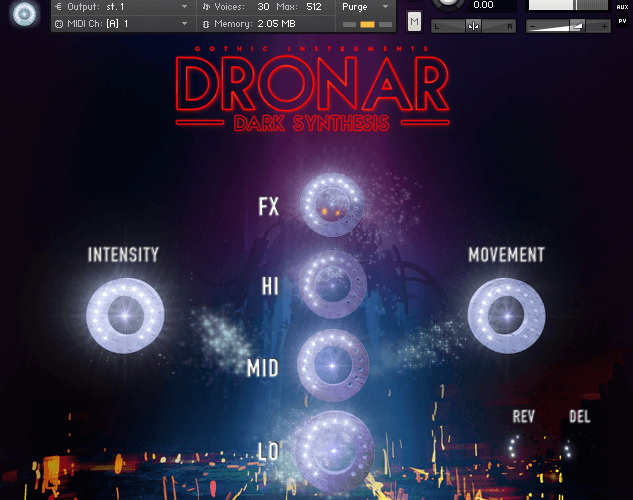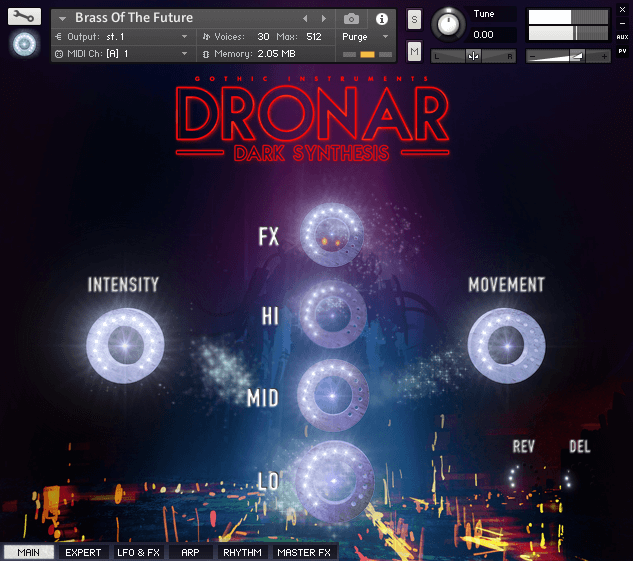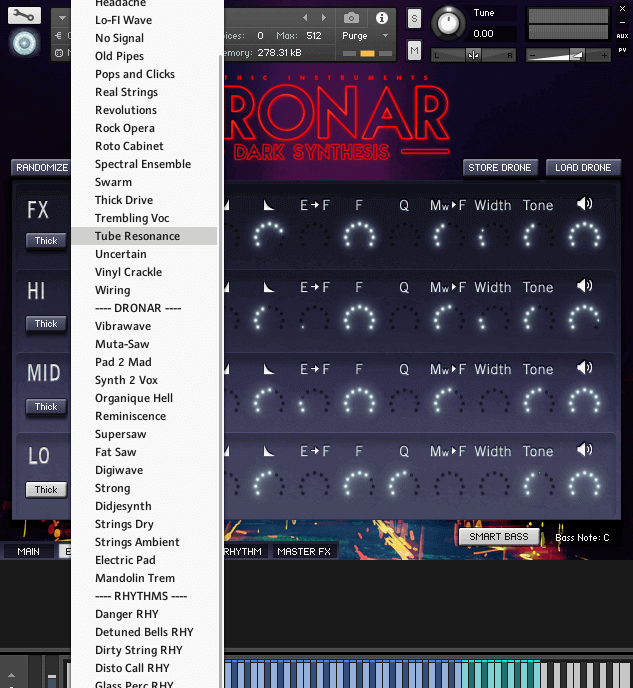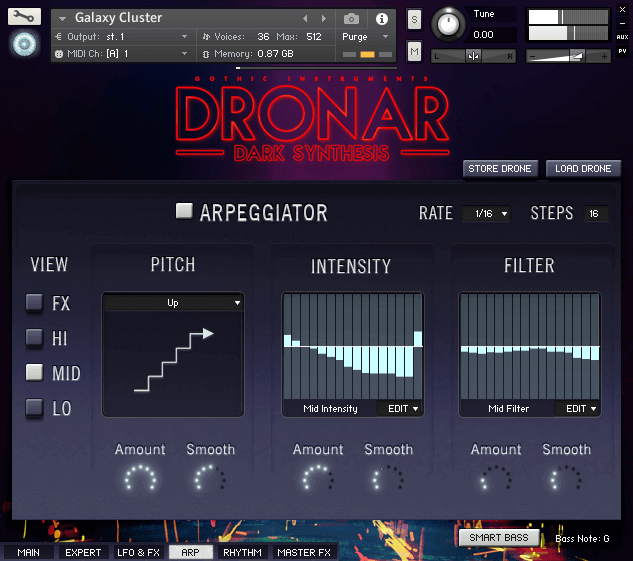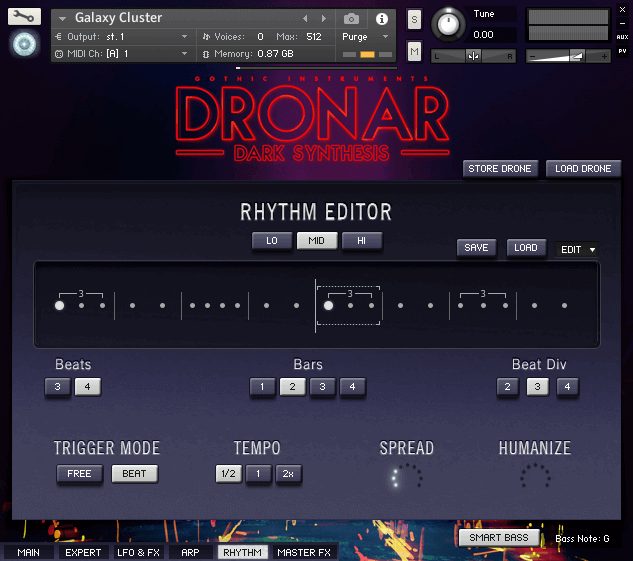The fourth module in the Dronar series from Gothic Instruments is Dark Synthesis, a sound design tool for Native Instruments Kontakt with a focus on a darker, cinematic sound palette.
This Dark Synthesis Module creates dark, eerie and mysterious synthetic textures by combining strange synth waveforms with complex processed real world recordings with a huge set of controls that invite deep exploration, expression and discovery.
Similar to previous Dronar instruments, Dark Synthesis uses a multi-layer engine with up to 8 different sounds to create atmospheres.
The main interface is simple, having just a few dials. The “FX”, “HI”, “MID” and “LO” controls dial in one of 4 layers with 2 sounds each. These are long, complex loops with 3 dynamic levels.
You can open up the sound with the “Intensity” control, adding multiple layers for each sample to achieve more dynamics. The “Movement” control sets the intensity of the built-in arpeggiators. Furthermore, the main page has “REV” and “DEL” for reverb and delay sends.
The sounds
The audio for Dark Synthesis was crafted by sound designer and synthesis enthusiast Adam Pietruszko and Hollywood movie trailer sound designer Alessandro Camnasio.
The presets were done by Vinko Borcic, Kyle Kniceley, Marie-Anne Fischer, Jonathan Sharp, and Adam Pietruszko.
Here’s what Adam had to say about his work on the library.
Doing sound design for this library was a great experience, as given its eerie, dark and disturbing nature, I was free to do whatever I wanted in “the twisted” department, not having to adhere to music rules or style constraints. It has been a while since I’ve worked on designing such sounds, so I was excited to jump right in.
This sort of mood is what I have been focussing on in my early work as a sound designer. So now, armed with a lot more experience than when I was starting out, I could really show my creative potential.
As for the technical side, Adam explains he used a combination of analog and digital synthesizers with quite a lot of processing.
The main tool that allowed me to break away from sounding too “electronic and synthy” was physical modelling synthesis, processing with amp simulations, as well as reverb programming.
The result is pretty scary and unsettling, so I imagine people using Dronar Dark Synthesis for scoring suspense moments in film, as well as adding an unusual flavour to their music tracks across electronica, ambient, techno and related genres.
The library comes with 14 instrument categories, with 12 instruments each. These “drones” can be loaded individually or you can use a collection of “Menu” patches that has key switches for each of the 12 drones within the category. When loading individual drones, the same drone is spread across all 12 key switches so you can easily create variations.
The “Expert” page shows which sound sources are used for the drones, and here you can swap out sounds (or even randomize them all) and control various parameters for each layer.
The sample selection is different for each one of the layers. Controls for each layer include a slider to blend sounds, attack and release, filter, envelope and modwheel to filter, width, tone and volume. The “Thick” button adds extra notes to get a bigger sound.
Evolving atmospheres
To add some more color to the sounds, Dark Synthesis features an LFO and some effects (distortion, chorus, reverb and delay). These effects are drone specific, unlike the ones found on the “Master FX” tab, which are global for all loaded drones. The Dronar engine also has a nice arpeggiator and a rhythm editor, which allows you to further add movement to the atmospheres.
The “Arpeggiator” has global rate and steps, and you can set individual pitch, intensity and filter parameters for each of the 4 layers.
The PITCH arpeggiator as far as we know is an original type of arpeggio generator not found elsewhere. Whereas other arpeggiators re-trigger the note at every step, DRONAR’s pitch arpeggiator plays all the notes that you are holding down but cross-fades between them.
This is like having the different notes of a chord all going through different channels on a mixing desk, then turning the faders in succession to create the impression of an arpeggio.
“Amount” and “Smooth” controls blend and fade the notes.
When using rhythm samples as a sound source, the “Rhythm Editor” offers some tools to change the patterns.
Dark synthesis rhythm samples (as found in the sample selection menus on the EXPERT page) were performed live for a natural sound where no two adjacent notes are exactly the same and
they therefore have a certain flow compared to triggers of single samples.They were also recorded at 3 dynamics (soft, medium, loud) allowing you to accent your rhythms using the Mod Wheel to fade between dynamics.
Setting the amount of beats and bars and a beat division, you can create new patterns on the fly. Dronar triggers the original loop at different positions to create new rhythms in real-time.
The tempo can be set to half-speed, host speed, or double the speed and a “Spread” control allows for a natural strummed effect. “Humanize” offers a more loose timing. The rhythm can run free or beat synced.
Lastly, the “Master FX” page mentioned earlier features some global effects: EQ, compressor, delay, reverb, and a gater. It is worth mentioning that the reverb comes with some nice convolution impulses, including creative and unusual ones for sound design.
Check out the video below to hear the atmospheres of one of the menu presets: Argento Drones by Vinko Borcic. Note that I am pressing a single note most the time.
Make sure to listen to the sound demos on the Dark Synthesis product page as well, as this library has a lot more to offer than the short clip above.
So what do I think?
Dronar is a very interesting concept. By playing just a single note or a few notes, the instrument provides rich sounding atmospheres, dynamic and full of movement.
With a huge library of ready to go sounds at your fingertips, Dark Synthesis offers a fast and very satisfying way of creating atmospheres and textures. It is straightforward and easy to use, yet it goes much deeper than at first appears. With its sound design tools you can further shape the sounds of the presets to your liking, or even create brand new atmospheres from scratch.
Dark Synthesis is probably best suited to cinematic soundtracks, but I reckon it is flexible enough to be equally useful for other projects that need a touch of darkness.
The library is available from Pulse Audio for $67 USD. Note that it requires the full version of Kontakt 5.6 or higher.
More information: Sonora Cinematic


